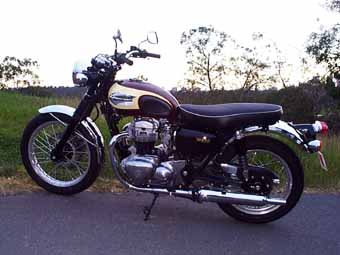Road tests
Kawasaki W650
(mid 1999)
No apologies

Kawasaki makes no apologies for the retro looks of its W650.
My spouse, Ms M senior, has long had a hankering to own a Brando-style
black leather jacket. Not just any Brando jacket, but one with "Princess
Moll" emblazoned across the shoulders in silver studs. I've just discovered
the bike to go with the clothing -- it's Kawasaki's W650.
The minute you get on the thing, you start thinking big boots, flying
goggles and Brylcream. Rockers.
FOR ONCE
For once I agree with K's sales blurb, which says, "However enamoured
one may be with the high performance and advanced technology of modern
motorcycles it is impossible to deny the aesthetic qualities of the machines
of yesteryear." And the W650 has that aplenty.
It's a direct replica of the Meriden twin Triumphs of the sixties and
the Kawasaki mob makes no apologies for the fact. Which is fine by me,
so long as the bike works. It does.
Within 24 hours of the W's relationship with Chateau Fred, Port, Wootton
and self were wandering around blathering on about how much fun it is to
ride. Maybe our expectations were low, but first impressions are often
accurate when it comes to test bikes.
MEGURO WHO?
The story starts way back in 1961-62 when Kawasaki bought out the Japanese
Meguro
factory. One of its models was a 500 twin that was a direct rip-off of
the BSA/Triumph equivalent.
In 1967 Kawasaki
released its 650 version of the Meguro which, if you squint, could easily
be mistaken for today's bike.
The basis of the plot is a 676cc, 360-degree, four-stroke vertical twin
that's air-cooled. It runs a five-speed gearbox with multiplate clutch
and chain final drive.
Its double-cradle steel frame runs conventional 39mm forks, twin shocks
with preload adjustment only, a single disc front brake with two-pot caliper
and a mechanical drum rear. Yep, it's reading like a spec sheet out of
the sixties.
The four-valve-per-pot head runs a single overhead bevel-driven cam,
while there's a clean-burn fresh air injection system for the exhaust side
and a balance shaft somewhere in the bottom end.
There's a claimed 48-ish horses pushing the 195-kilo dry weight. Add
in a 15-litre fuel tank and modest tyre sizes (100/130 widths front/rear)
on laced rims and you have the general plot. Oh and there's a (drumroll
please, maestro) real, live, kick-start in addition to the lecky version.
ADDING UP
What it adds up to is a toy that you hit the button on and blurt out
into the scenery, accompanied by a muted and very pleasant bass rumble
from the stock pipes.
It's a smallish and very agile bike. Narrow though not particularly
low in the seat. The wide buckhorn handlebars make the steering light and
manageable, while the engine response is entirely predictable.
Urge comes in strongly from not much right through to 7000rpm, where
it tapers off rapidly. A brisk pace through town or a set of curves encourages
gearchanges in the 3500-4500 range rather than having to rev the ring out
of it. Top gear at 100kmh works out to 3700rpm, where there's good overtaking
grunt on tap.
Take a packed lunch and you might get a genuine 160kmh (or the old 'ton')
top speed. Where the W is happiest, though, is belting along at steady
120-130kmh ? which suits the upright riding position.
Steering is neutral, while suspension response is pretty good. The
back end will struggle with the combo of a heavy load and big bump, when
it hits the stops.
Speaking of stops, the brakes are fine. Not super-sharp, but with plenty
of feel and power for solo use.
Chuck it into a corner and you'll find the hero knobs on the rider
footpegs grinding fairly easily -- I'd remove them, as they're crying foul
before the bike or tyres are.
Gearchanges are slick, and the clutch light with a broad take-up band.
COMFORTS
The seating position is classic upright twin stuff, with a relatively
thin seat that has what seems to be a well-chosen padding material. Tall
riders will find their knees sit too high on the deeply-dished tank pads.
Pillions don't have a hell of a lot of room, and would be better served
by a grab handle at the rear of the seat. My guess is that simple chromed
luggage racks will be a popular accessory.
Instrumentation is twin speedo/tacho pods that look more or less trad
(as does the switchgear), though there's a digital window which offers
an odometer, tripmeter and a clock.
In case you were wondering, the vertical twin vibes are there, but in
a civilised and muted form.
RELATIONSHIPS
A quick squiz over the motorcycle suggests that maintenance is within
reach of a moderately competent home mechanic. Though he or she may have
to relearn things, like how to tension a laced spoke wheel...
The $10,990 price falls somewhere between the Honda Hornet and the base-model
Triumph T-bird Legend, which raises some interesting questions for the
punter. Both those bikes have more performance, but the W's feel is in
a little class of its own.
It's by no means at the cutting edge of motorcycledom, and doesn't pretend
to be. But I can see owners developing a long and very relaxed relationship
with the thing, assuming it turns out to be as reliable as the rest of
the marque's machinery.
After the first ride, I got a peculiar urge to find a backpack, stuff
in some clothes, and go looking for somewhere to play for a few days. Since
I have possession of the ignition key, Princess Moll will have to wait
her turn.
Guy Allen
[Roadtests | Motorcycle
Books]
![]()

![]()